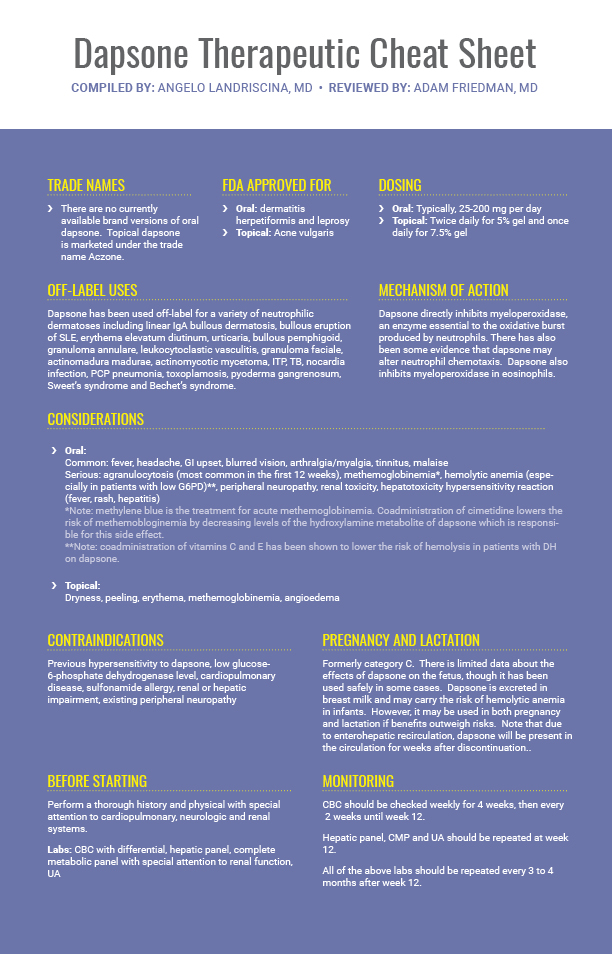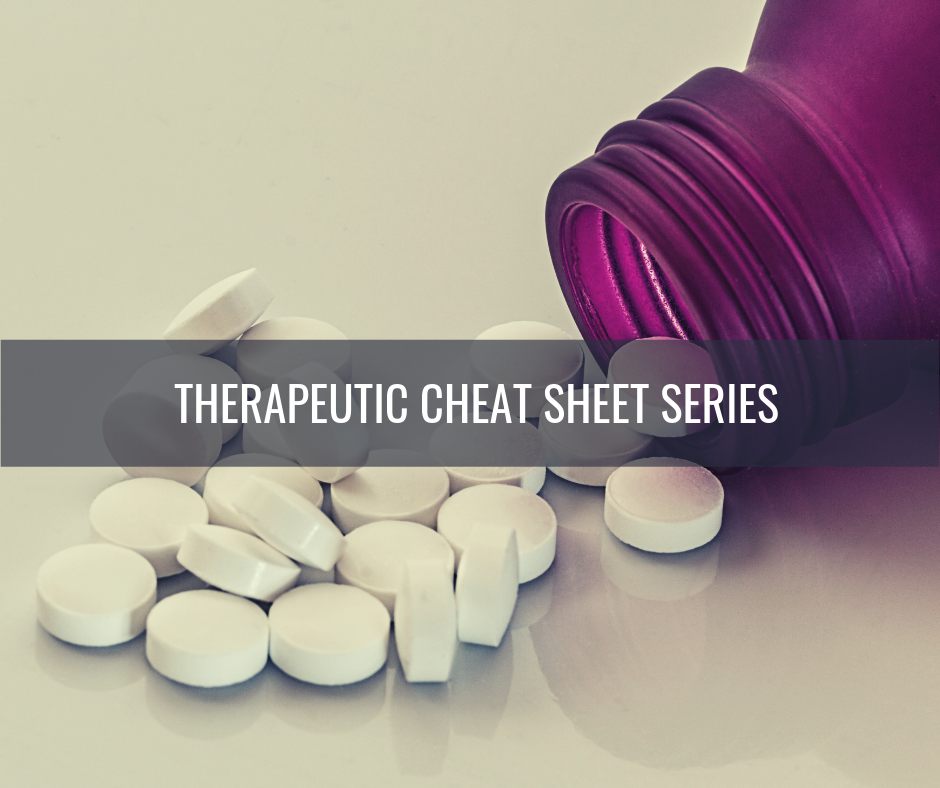Welcome to another installment of our Therapeutic Cheat Sheet series! In this series, we take the guess work out of complicated therapeutics by providing everything you need to know in a printable cheat sheet. This month we’re focusing on dapsone, a versatile medication that can be used safely if you’re aware of what to look for. Here’s what you need to know about dapsone.

Further Reading
If you would like to read more about Dapsone , check out the following articles published in the Journal of Drugs in Dermatology:
![]() Efficacy of Systemic Dapsone Treatment for Pyoderma Gangrenosum: A Retrospective Review
Efficacy of Systemic Dapsone Treatment for Pyoderma Gangrenosum: A Retrospective Review
INTRODUCTION: Pyoderma gangrenosum (PG) is a neutrophilic dermatosis commonly treated with steroid immunosuppression. The utility of dapsone as a non-immunosuppressive treatment for PG has been reported in case reports and series. We sought to evaluate the response and tolerability of concurrent systemic dapsone therapy for treating PG. METHODS: We reviewed PG patients treated with systemic dapsone at Massachusetts General Hospital and Brigham and Women’s Hospital from 2000-2015. A treatment episode was defined as a minimum of 4 weeks of dapsone therapy with a documented response of complete, partial, or no improvement in wound healing. RESULTS: 27 patients treated with systemic dapsone met inclusion criteria. 15.6% of treatment episodes demonstrated a response of complete healing, 81.3% of treatment episodes demonstrated a response of partial improvement, and 1 patient (3.1%) demonstrated no response. 9 patients (33.3%) had documented side effects of varying severity, with one (3.7%) requiring cessation of dapsone therapy. DISCUSSION: Systemic dapsone therapy may represent an effective and tolerable non-immunosuppressive adjuvant treatment for PG wound healing. J Drugs Dermatol. 2018;17(10):1058-1060.
![]() Once-Daily Topical Dapsone Gel, 7.5%: Effective for Acne Vulgaris Regardless of Baseline Lesion Count, With Superior Efficacy in Females
Once-Daily Topical Dapsone Gel, 7.5%: Effective for Acne Vulgaris Regardless of Baseline Lesion Count, With Superior Efficacy in Females
INTRODUCTION: Acne vulgaris is more common in females than males and is challenging to treat. A post hoc analysis of 2 clinical trials evaluated the effect of dapsone gel, 7.5% based on sex and baseline acne lesion count. METHODS: Two identically designed, randomized, double-blind, vehicle-controlled, multicenter, 12-week, phase 3 trials enrolled patients aged ≥12 years with facial acne and 20 to 50 inflammatory and 30 to 100 comedonal lesions. Patients applied dapsone gel, 7.5% or vehicle topically once daily for 12 weeks. Baseline to week 12 reductions were evaluated for total, inflammatory, and comedonal lesions in the pooled dapsone population by sex and total baseline acne lesion count (low: 50–74, medium: 75–99, and high: ≥100). RESULTS: The analysis included 2160 patients (56% female, 44% male). Males and females had similar average baseline total, inflammatory, and comedonal lesion counts. Low, medium, and high subgroups experienced efficacy with dapsone gel, 7.5%. Females in each subgroup experienced superior efficacy to males. In females, total lesion counts in the low, medium, and high subgroups decreased by 56.07%, 50.22%, and 47.63%, respectively, compared with 47.95%, 42.30%, and 34.68% in males (P less than 0.001 for each male-female comparison). Females’ respective inflammatory lesion count percentage reductions were 60.96%, 57.91%, and 55.83%, versus 52.75% (P less than 0.001), 46.85% (P less than 0.001), and 44.70% (P=0.008) in males. Females’ respective comedonal lesion count percentage reductions were 52.96%, 45.40%, and 44.22%, versus 44.67% (P less than 0.001), 39.38% (P=0.030), and 29.89% (P=0.001) in males. The TEAE rate was low for the overall population (18.3%) and similar for females (19.0%) and males (17.4%). Males and females had similarly favorable dermal tolerability. CONCLUSION: Once-daily dapsone gel, 7.5% was efficacious for acne regardless of baseline total lesion count, with superior efficacy in females and similar tolerability in males and females. REGISTRATION IDENTIFIER: Clinicaltrials.gov: NCT01974141 and NCT01974323 J Drugs Dermatol. 2018;17(11):1192-1198.
Did you enjoy cheat sheet? You can find more here.

